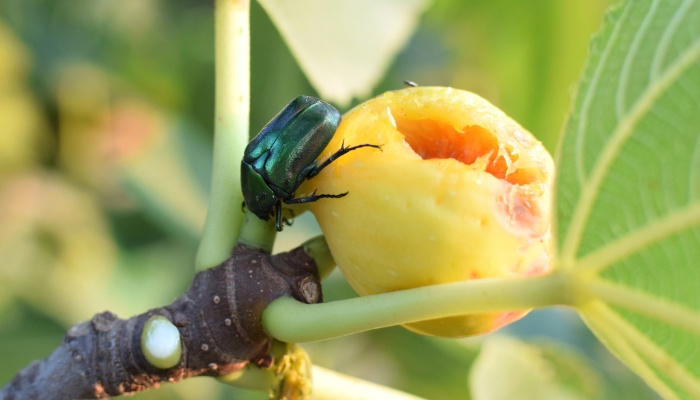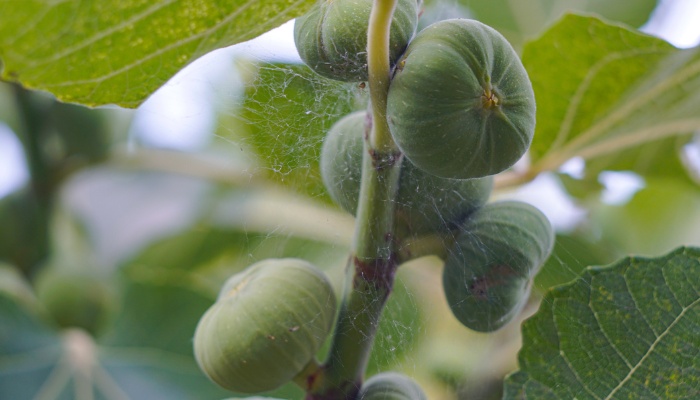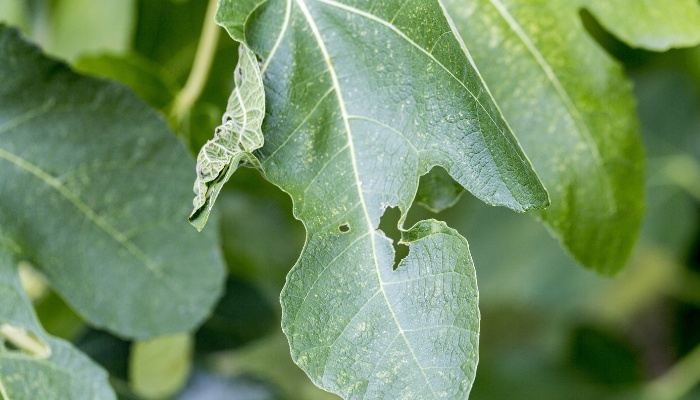Fig trees are a beloved choice among gardeners because of their abundant greenery and delectable fruit. Just like any other plant, they are vulnerable to a range of illnesses, pests, and other potential issues.
Understanding these issues and knowing how to identify and address them is crucial for maintaining a healthy fig tree.
In this guide, we’ll cover the common diseases, pests, and problems that fig trees can encounter, providing you with the knowledge to keep your fig tree in top shape.
Don’t be overwhelmed by how much there is to learn about caring for your apple tree. Take it one step at a time — I show you how in my ultimate Fig Tree Guide. Check it out today!
Common Fig Tree Diseases
Fig trees can be affected by several diseases. Below, we’ll discuss each disease, its symptoms, and how to manage it.
1. Fig Mosaic Virus
Fig mosaic virus is a common disease that affects fig trees. Symptoms include mottled, distorted, and yellowing leaves.
The disease is spread by pests and through the use of infected cuttings. While it doesn’t usually kill the tree, it can weaken it and reduce fruit production.
Solution
There’s no cure for fig mosaic virus, so the best approach is prevention. Use disease-free cuttings for propagation, control pests that can spread the virus, and remove and dispose of infected leaves.
2. Rust
Rust is a fungal disease that causes small, orange-brown spots on the undersides of leaves. As the disease progresses, the leaves may yellow and drop prematurely.
Solution
To manage rust, remove and dispose of infected leaves. Apply a fungicide labeled for rust control, and improve air circulation around the tree by pruning and spacing plants properly.
3. Blight
Blight, caused by several types of fungi, results in wilting, browning, and death of branches. The affected branches often have a “burned” appearance.
Solution
Prune and dispose of infected branches, sterilizing your pruning tools between cuts. Apply a fungicide labeled for blight control. This one works well.
4. Anthracnose
Anthracnose causes dark, sunken spots on leaves, stems, and fruit. The spots may enlarge and merge, causing large areas of tissue to die.
Solution
Remove and dispose of infected plant material. Apply a fungicide labeled for anthracnose control. Improve air circulation around the tree by pruning.
5. Powdery Mildew
Powdery mildew is a fungal disease that presents as a white, powdery coating on leaves, stems, and sometimes fruit. Infected leaves may curl, yellow, and drop prematurely.
Solution
Improve air circulation and sunlight penetration by pruning. Apply a fungicide labeled for powdery mildew control.
6. Leaf Spot
Leaf spot diseases cause spots on leaves that may be of various colors and sizes. The spots may have a concentric ring pattern and may cause the leaves to yellow and drop.
Solution
Remove and dispose of infected leaves. Apply a fungicide labeled for leaf spot control.
7. Canker
Canker diseases cause sunken, discolored areas on the bark. The affected areas may ooze sap or have a foul smell.
Solution
Prune and dispose of infected branches. Sterilize your pruning tools between cuts. Apply a fungicide labeled for canker control.
8. Root Rot
Root rot is usually caused by overwatering or poor drainage. Symptoms include wilting, yellowing leaves, and stunted growth. The roots may be dark and mushy.
Solution
Improve soil drainage and avoid overwatering. Remove and dispose of severely infected trees. Fungicides may help in the early stages of the disease.
9. Botrytis Fruit Rot
Botrytis fruit rot causes soft, watery spots on fruit that enlarge and become covered with a gray, fuzzy mold.
Solution
Remove and dispose of infected fruit. Improve air circulation around the fruit by pruning. Apply a fungicide labeled for Botrytis control.
10. Crown Gall
Crown gall causes round, wart-like galls on roots and at the base of the trunk. The galls interfere with water and nutrient uptake, leading to reduced vigor and yield.
Avoid injury to the tree because the bacteria that cause crown gall enter through wounds.
Solution
There’s no cure for crown gall. Remove and dispose of infected trees.
Common Fig Tree Pests
Fig trees can be host to a variety of pests. Below, we’ll discuss each pest, its symptoms, and how to manage it.
1. Fig Scale
Fig scale insects are small, flat, and often covered with a waxy or cottony coating. They suck sap from the tree, causing yellowing and wilting of leaves. Heavy infestations can lead to branch dieback.
Solution
Prune and dispose of heavily infested branches. Apply a horticultural oil or insecticidal soap, following the package instructions.
2. Beetles

Certain beetles, like the figeater beetle or June beetle, are attracted to ripe figs. They can cause damage by boring into the fruit.
Solution
Pick figs as soon as they ripen to reduce the attraction. Use traps or environmentally friendly pesticides if the infestation is heavy.
3. Aphids
Aphids are small, soft-bodied insects that suck sap from the leaves and stems. They can cause leaves to curl, yellow, and drop.
Aphids also excrete a sticky substance called honeydew, which can lead to sooty mold.
Solution
Spray the tree with a strong stream of water to dislodge aphids. Use insecticidal soap or neem oil for heavy infestations.
4. Whiteflies
Whiteflies are tiny, white insects that suck sap from the undersides of leaves. Like aphids, they excrete honeydew, leading to sooty mold. Infested leaves may yellow and drop.
Solution
Use yellow sticky traps to catch adult whiteflies. Apply insecticidal soap or neem oil to control the immature stages.
5. Spider Mites

Spider mites are tiny, spider-like pests that suck sap from the undersides of leaves. They can cause stippling and yellowing of leaves, and heavy infestations can lead to leaf drop.
Solution
Spray the tree with a strong stream of water to dislodge mites. Use a miticide or insecticidal soap for heavy infestations.
6. Borers
Borers are the larvae of certain beetles and moths. They bore into the trunk and branches, causing wilting, dieback, and sometimes tree death.
Solution
Prune and dispose of infested branches. Apply a borer-specific insecticide to the tree, following the package instructions.
7. Mealybugs
Mealybugs are small, soft-bodied insects covered with a white, cottony coating. They suck sap from the leaves and stems, causing wilting and yellowing.
They also excrete honeydew, leading to sooty mold.
Solution
Use a cotton swab dipped in alcohol to remove mealybugs. Apply insecticidal soap or neem oil for heavy infestations.
8. Fruit Flies
Fruit flies are attracted to overripe and rotting figs. They lay their eggs in the fruit, and the larvae feed on the fruit when they hatch.
Solution
Pick figs as soon as they ripen, and dispose of any fallen or rotting figs. Use traps or environmentally friendly pesticides if necessary.
9. Harmful Nematodes
Certain nematodes, or microscopic worms, can damage the roots of fig trees. Symptoms include wilting, yellowing, stunted growth, and reduced yield.
Solution
Use nematode-resistant varieties or rootstocks. Apply a nematicide if the infestation is heavy.

Common Fig Tree Problems
Apart from diseases and pests, fig trees can encounter other problems. These issues can often be resolved with proper care and maintenance.
1. Slow Growth
Slow growth can be caused by various factors, including poor soil, inadequate light, insufficient water, or lack of nutrients.
Solution
Ensure your fig tree is planted in well-draining soil and receives at least 6-8 hours of sunlight each day. Water regularly, especially during dry periods, and feed with a balanced fertilizer in early spring.
2. Poor Fruit Production
Poor fruit production can be due to inadequate pollination, lack of nutrients, insufficient light, or improper pruning.
Solution
Ensure your fig tree gets plenty of sunlight and is fed with a balanced fertilizer in early spring. Prune correctly, removing only dead, diseased, or crossing branches.
3. Poor Fruit Quality
Poor fruit quality can be due to insufficient water, lack of nutrients, or pest and disease problems.
Solution
Water your fig tree regularly, especially during dry periods, and feed with a balanced fertilizer in early spring. Monitor for pests and diseases, and take action at the first sign of trouble.
4. Fruit Souring
Fruit souring is often caused by overripe fruit that has been attacked by insects or infected with a fungal disease.
Solution
Pick figs as soon as they ripen, and dispose of any fallen or rotting figs. Monitor for pests and diseases, and eradicate the problem quickly.
5. Fig Tree Leaves Turning Brown
Leaves turning brown can be due to underwatering, overwatering, lack of nutrients, or a disease problem.
Solution
Ensure your fig tree is watered correctly, meaning not too much or too little. Feed with a balanced fertilizer in early spring. Monitor for diseases, and treat issues promptly.
6. Fig Tree Leaves Turning Yellow
Leaves turning yellow can be due to overwatering, lack of nutrients, or a disease or pest problem.
Solution
Ensure your fig tree is not overwatered. Feed with a balanced fertilizer in early spring. Monitor for pests and diseases routinely, and apply treatment as soon as possible.
7. Early Leaf Drop
Early leaf drop can be due to underwatering, overwatering, a sudden change in temperature or light, or a disease or pest problem.
Solution
Ensure your fig tree is watered correctly and is not exposed to sudden changes in temperature or light. Remedy any pest or disease issue as soon as you notice a problem.
8. Fig Tree Leaves Drooping
Leaves drooping can be due to underwatering, overwatering, or a disease or pest problem.
Solution
Ensure your fig tree is watered correctly, not too much or too little. Inspect trees regularly for insect damage or signs of disease, and treat immediately.
Closing Thoughts
Fig trees are relatively easy to care for, but they can encounter various diseases, pests, and other problems.
By understanding these issues and knowing how to identify and address them, you can keep your fig tree healthy and productive for many years.
The key to successful fig tree care is regular monitoring, proper watering and feeding, and prompt action at the first sign of trouble, so be diligent!
